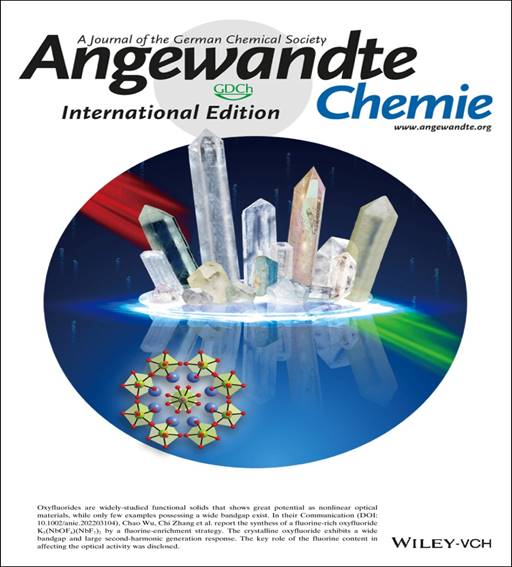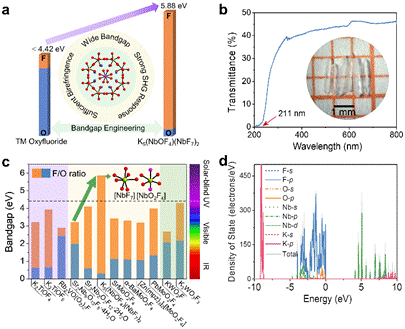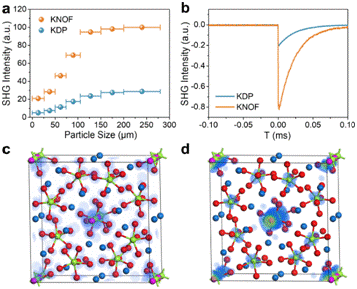
Deep UV and solar-blind ultraviolet nonlinear optical crystal materials have great practical applications in such fields as laser technology, medical diagnosis, short-wave communication, fire monitoring and laser guidance. At present, the ultraviolet nonlinear optical crystals that have been preliminarily commercialized cannot meet the needs of short-wave ultraviolet frequency conversion due to their structural defects or phase mismatch, which greatly hinders the rapid development of modern laser crystal technology and its practical application in high-tech fields. It is one of the hot and difficult issues in the research field of ultraviolet nonlinear optical crystal materials to develop crystals that can be applied to ultraviolet and deep ultraviolet bands with excellent performance, especially crystals with large second-order nonlinear coefficients and wide band gaps and capable of phase matching.
The research team of Academician Zhang Chi of our school proposed a molecular design strategy for enriching highly electronegative fluoride anions to regulate the energy band structure by taking oxyfluoride as the research object and designed and createdK5(NbOF4)(NbF7)2 (KNOF), a solar-blind UV nonlinear optical crystal material with broadband gap and strong frequency doubling response. The research outcome "Ultrawide Bandgap and Outstanding Second-Harmonic Generation Response by a Fluorine Enrichment Strategy at a Transition-Metal Oxyfluoride Nonlinear Optical Material" was published in "Angewandte Chemie", an international authoritative academic journal of German(Angew. Chem. Int. Ed., 2022, e202203104),as anewsletteron May 17th and was selected as the cover article of the journal by the editorial board of Angewandte Chemie(Angew. Chem. Int. Ed., 2022, e202206423).
In the research, the research team of Academician Zhang Chi proposed a molecular design strategy of enriching fluoride anions to regulate the energy band structure for the first time, created KNOF, a transition metal oxyfluoride with a fluorine-oxygen ratio of up to 18:1 in the molecular structure, and explored the important influence of transition metal central oxyfluoride polyhedron on the structure, band gap and second harmonic performance of crystal materials. From the angle of molecular structure, a high fluorine-oxygen ratio is beneficial to eliminate the oxygen-fluorine disorder in the central polyhedron of transition metal, which leads to the long-range ordered arrangement of the central polyhedron of transition metal and promotes the formation of noncentrosymmetric structure. However, based on the optical properties of the material, the unreplaced oxygen atoms in the transition metal central polyhedron can be used as a structural-directing agent, so that the transition metal central polyhedron preferentially polarizes in the same direction and induces a strong frequency doubling response in the molecular system. Since the main contribution from the top of the material valence band comes from the fluorine 2p electron orbital, when the oxygen sites in the transition metal center polyhedron are partially or even completely replaced by the more electronegative fluoride ions, the top of the valence band will move to the lower energy, resulting in the widening of the band gap.


Through structural analysis of single-crystal X-ray diffraction, the research team of Zhang Chi revealed the influence mechanism of the [NbO2F4] and [NbF7] metallic niobium center polyhedra rich in extreme fluorine anions in the KNOF molecular structure on the linear and second-order nonlinear optical properties of materials. Fluoride anions act as chemical "scissors" to allow the structure to be composed of one-dimensional [NbO2F4]∞ chains and separated [NbF7] polyhedrons, thereby effectively reducing the dimension of the structure. Influenced by the second-order Jahn-Teller effect, niobium cations form partially fluorinated [NBO2F4] octahedrons and fully fluorinated [NbF7] polyhedrons. These distorted polyhedrons are aligned uniformly along the c-axis, allowing a large SHG response. In the niobium central polyhedron, increasing the fluorine-oxygen ratio can inhibit the movement of the top of the valence band dominated by oxygen 2p electron orbitals to higher energy. The fluorine-oxygen ratio in KNOF is much higher than other transition metal oxyfluorides, and this fluorine-rich environment not only weakens the interaction between niobium cations and oxygen in the [NbO2F4] group but also promotes the formation of an ordered and fully fluorinated [NbF7] group in the structure, both of which broaden the transparent range of UV light. The research team further applied the first-principles theoretical simulation calculation to explore and elucidate the internal physical mechanism of KNOF to achieve a strong SHG response and wide band gap at the same time and explained that the strong SHG response is mainly caused by the order arrangement of highly distorted partially fluorinated [NbO2F4] and fully fluorinated [NbF7F4] polyhedrons, while the broadband gap is derived from the highly fluorinated transition metal central polyhedron in the material structure. The inorganic crystal KNOF has a wide optical band gap (5.88 eV, corresponding to the ultraviolet absorption cutoff of 211 nm solar blind ultraviolet region), a strong frequency-doubling response (4.0 × KH2PO4 @ 1064 nm) and a moderate birefringence (0.07 @ 546 nm). The research provides a new research and design idea for exploring second-order nonlinear optical crystal materials with the short-wave ultraviolet transmission.

Recently, the research team of Academician Zhang Chi also proposed a compound cationic salt strategy with non-π-conjugated sulfate as the research object and constructed a deep ultraviolet second-order nonlinear optical crystalline material of rare earth-based sulfate with a strong SHG response. The research outcome"A Lanthanum Ammonium Sulfate Double Salt with a Strong SHG Response and Wide Deep-UV Transparency"was published online as a newsletter in "Angewandte Chemie"(Angew. Chem. Int. Ed., 2022, 61(6), e202115855).


The above series of research work has gained wide support from the Key Projects of the National Natural Science Foundation of China, the Program for Innovative Research Team in University by the Ministry of Education, the Program for Innovative Research Team in Key Fields by the Ministry of Science and Technology, the MoE-SAFEA "111 Project", Key Projects of Science and Technology Innovation Plan of Shanghai Municipal Education Commission, etc. Academician Zhang Chi is the corresponding author of the paper, doctoral student Wu Tianhui and Associate Professor Wu Chao are the first authors of the paper, and Professor Huang Zhipeng has participated in the research work.